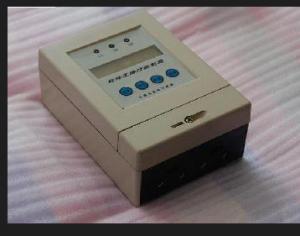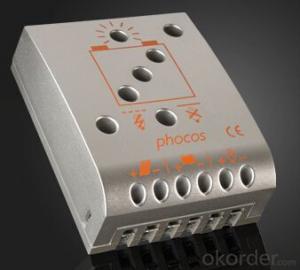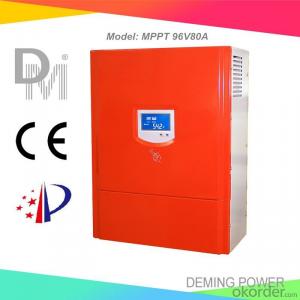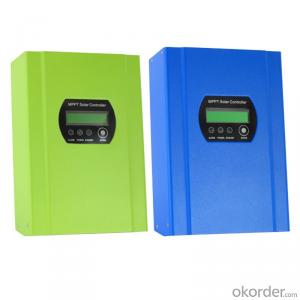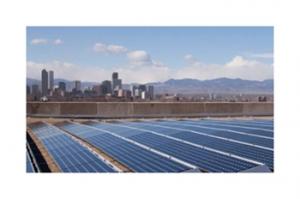2 Solar Charge Controllers MPPT Solar Charge Controller 96V 30A with Best Price for Solar Power System
- Loading Port:
- Qingdao
- Payment Terms:
- TT or LC
- Min Order Qty:
- 1 PCS
- Supply Capability:
- 1000 PCS/month
OKorder Service Pledge
OKorder Financial Service
You Might Also Like
Properties of the solar charge controller
1. Design for off-grid solar power system.
2. Applicable to different kinds of batteries.
3. Modular design with simple structure and easy maintenance.
4. LCD display: Solar panel current, solar panel voltage, solar panel power, battery group voltage, charge current.
Technical parameters of the solar charge controller
Model | 96V30A | |||||
Battery group rated voltage | 96Vdc | |||||
PV Rated current | 30A | |||||
PV open circuit voltage | 400V | |||||
PV Max. power | 2880Wp | |||||
Input PV module road number | 1 | |||||
Function | MPPT charge mode, auto stop charge, auto recharge voltage; Protection: connecting contrary, over current, short circuit, over heat etc. | |||||
Display mode | LCD | |||||
Display content | solar panel voltage, solar panel current, solar panel power, battery voltage, charge current | |||||
MPPT DC voltage rang | 80-116Vdc | |||||
Floating Charge Voltage (adjustable) | 110Vdc | |||||
Stop charge voltage | 116Vdc±1% | |||||
Recharge voltage | 108V±1% | |||||
Voltage drop between PV and battery | 1.5V | |||||
Max itself power consumption | 100mA-150mA | |||||
Work environment temperature | -30-60°C | |||||
Relative humidity | 90% No condensation | |||||
Applicable altitude | 3000m The rated power should be reduced when it is higher than 2000m | |||||
Noise (1m) | 40dB | |||||
Degree of protection | IP20(Indoor) | |||||
Cooling method | Forced air cooling | |||||
*Communication interface (optional) | RS485/USB/GPRS/Ethernet | |||||
*Temperature compensation(optional) | -4mv/°C/2V,-35°C~+80°C,Accuracy:±1°C | |||||
Product size (mm) | 480*370*160mm | |||||
Product Weight(kg) | 12kg | |||||
*Above parameter only for reference. Could be custom made to user specifications.
Image

FAQ
Q1:Can we visit your factory? A1:Sure,welcome at any time,seeing is believing. Q2:How to guarantee the Quality of the products? A2:We have established the international advanced Quality management system,every link from raw material to final product we have strict Quality test;We resolutely put an end to unQualified products flowing into the market. At the same time, we will provide necessary follow-up service assurance.
- Q: How does a solar controller prevent damage from reverse current flow?
- A solar controller prevents damage from reverse current flow by incorporating a diode in its circuitry. This diode acts as a one-way valve, allowing current to flow from the solar panels to the battery, but not in the opposite direction. Thus, it ensures that the current generated by the battery does not flow back into the solar panels, preventing any potential damage or overcharging.
- Q: Can a solar controller be used with a portable solar panel setup?
- Yes, a solar controller can be used with a portable solar panel setup. A solar controller helps regulate the flow of electricity from the solar panels to the batteries, preventing overcharging and optimizing the charging process. It is especially useful in portable setups to ensure efficient and safe charging of batteries.
- Q: Can a solar controller be used with solar panel grounding systems?
- Yes, a solar controller can be used with solar panel grounding systems. In fact, it is highly recommended to have a solar controller as part of the overall system. The primary function of a solar controller is to regulate the amount of charge going into the batteries from the solar panels, preventing overcharging and extending the battery life. When it comes to solar panel grounding systems, they are designed to provide a safe path for electrical current in the event of a fault or lightning strike. Grounding systems generally consist of grounding rods, conductors, and bonding connections to ensure that any excess electrical energy is safely dissipated into the earth. The solar controller itself is not directly involved in the grounding system, as its main purpose is to regulate the flow of electricity from the solar panels to the batteries. However, it is important to ensure that the solar panel arrays are properly grounded and bonded according to local electrical codes and standards. To sum up, a solar controller can be used in conjunction with solar panel grounding systems, as they serve different purposes within the overall solar power system. It is crucial to follow the appropriate guidelines and regulations to ensure the safe and efficient operation of the entire system.
- Q: What is the standby current consumption of a solar controller?
- The standby current consumption of a solar controller refers to the amount of electrical current that is drawn from the power source when the controller is not actively controlling or regulating the solar system. It is typically very low, ranging from a few milliamperes (mA) to microamperes (μA), and is designed to minimize energy wastage when the solar system is not in use.
- Q: Can a solar controller be used with solar panels that are connected to a charge controller?
- Solar panels that are connected to a charge controller can indeed be used with a solar controller. This is a common setup in solar power systems. The charge controller is responsible for regulating and controlling the charging process of the batteries that are connected to the solar panels. On the other hand, a solar controller, also known as a solar charge controller or solar regulator, is specifically designed to regulate the voltage and current from the solar panels. Its purpose is to ensure that the power generated by the panels is suitable for charging the batteries. The solar controller has a crucial role in safeguarding the batteries from overcharging and over-discharging, which can significantly extend their lifespan. It also aids in maximizing the efficiency of the solar panels by preventing any mismatch between the panel's output and the battery's charging requirements. By utilizing a solar controller alongside a charge controller, you can guarantee that your solar panels are functioning at their best and your batteries are adequately charged. This results in a solar power system that is more efficient and dependable.
- Q: What is the role of a battery low voltage disconnect function in a solar controller?
- A battery low voltage disconnect function in a solar controller is responsible for automatically disconnecting the battery from the system when its voltage drops below a certain predetermined level. This function helps to protect the battery from being over-discharged, which can lead to irreversible damage and reduced lifespan. It ensures that the battery is kept at a safe voltage level, prolonging its overall performance and preventing potential hazards.
- Q: What is the maximum load voltage of a solar controller?
- The maximum load voltage of a solar controller refers to the highest voltage that can be handled and regulated by the controller when supplying power to a load.
- Q: How do I upgrade or expand a solar controller system?
- To upgrade or expand a solar controller system, you can follow these steps: 1. Determine the capacity and capabilities of your existing solar controller system. 2. Assess your energy needs and goals for the upgrade or expansion. 3. Research and select compatible solar controllers that meet your requirements. 4. Ensure compatibility with your existing solar panels, batteries, and other components. 5. Plan the installation process, considering wiring, mounting, and any necessary modifications. 6. Disconnect and safely remove any existing components that need to be replaced or expanded. 7. Install the new solar controller and connect it to your existing system following manufacturer instructions. 8. Test the new components and ensure they are functioning properly. 9. Monitor the performance of the upgraded or expanded system and make any necessary adjustments. 10. Consider consulting with a professional or hiring an experienced installer if you are unsure or need assistance.
- Q: How does a solar controller handle battery equalization?
- A solar controller handles battery equalization by monitoring the voltage levels of individual battery cells and applying a controlled overcharge to the battery bank. This process helps to ensure that each battery cell within the bank is charged to its maximum capacity, preventing imbalances and extending the overall lifespan of the battery.
- Q: Can a solar controller be used with solar panels that have different orientations?
- Yes, a solar controller can be used with solar panels that have different orientations. The role of a solar controller is to regulate the flow of electricity between the solar panels and the battery or load. As long as the solar panels are connected in parallel or through separate input channels, the solar controller can manage the power generated by panels with different orientations. However, it's important to note that panels with similar orientations will typically generate more efficient and consistent power output.
Send your message to us
2 Solar Charge Controllers MPPT Solar Charge Controller 96V 30A with Best Price for Solar Power System
- Loading Port:
- Qingdao
- Payment Terms:
- TT or LC
- Min Order Qty:
- 1 PCS
- Supply Capability:
- 1000 PCS/month
OKorder Service Pledge
OKorder Financial Service
Similar products
Hot products
Hot Searches
Related keywords















